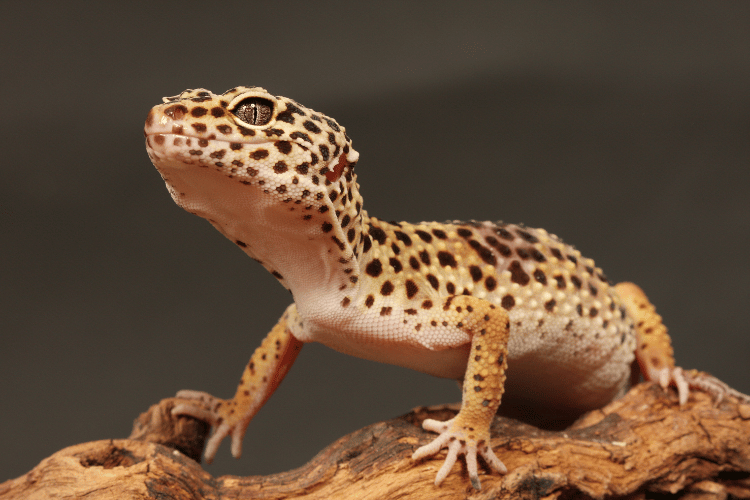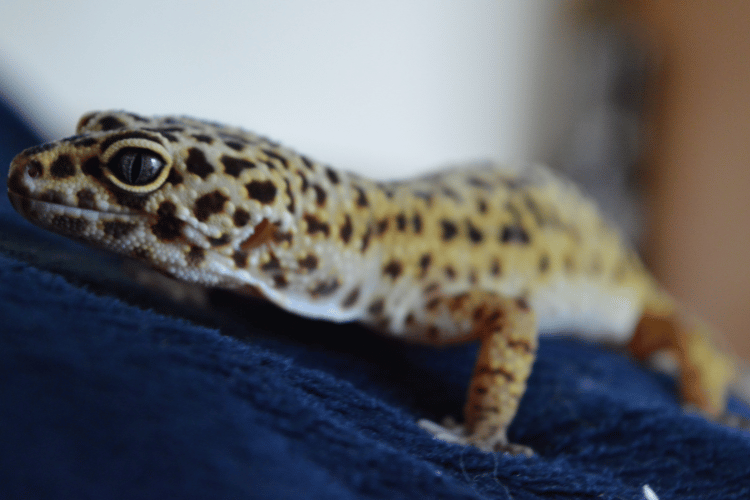Leopard geckos are common pet reptiles native to the deserts of Asia and are popular for their docile nature, small size, and ease of care.
Leopard geckos are ectothermic like all reptiles, which means they rely on external heat sources to regulate their body temperature. This requirement leads to confusion about whether leopard geckos actively “bask” in heat and light as other reptiles do.
So, do leopard geckos bask?
While leopard geckos lack the anatomy and behaviors for true basking, they still need heat from their environment not only for healthy physiological function but also to engage in heat-seeking behaviors that support their well-being.
Do Leopard Geckos Technically Bask?
Classic basking behavior is seen in many diurnal reptiles that climb or perch under focused spotlights or sunlight. The benefit is precise control over the heating of only the areas of the body facing the heat source through postural adjustments.
Signs of reptile basking include limb extension, pressing the body close to a warmth source, and changing positions to expose different body parts to the spotlight. True basking allows precision in heat absorption that aids vital physiological regulation.
Leopard geckos lack the anatomy and abilities for climbing, perching, or postural control needed for directed basking.
Low to the ground with short limbs, they can’t extend their bodies or adjust positions toward light sources. Instead, leopard geckos display a more general heat-seeking behavior by moving to warmer regions of their habitat.
While important for temperature regulation, this is more limited than a basking reptile precisely controlling heating via controlled sunlight exposure.
Still, proper heating is vital for a leopard gecko to thrive.

Leopard Gecko Heating Needs
While leopard geckos may not bask, access to adequate heat is still imperative.
Heat sources that should be provided include an under-tank heater on one side of the tank to create a temperature gradient and a ceramic heat emitter or heat bulb to create a basking spot up to 90°F.
Ideal tank temperatures range from 70-75°F on the cool end and 88-92°F on the warm end. At night, the temperature can drop but should not fall below 65°F.
Without supplemental heating, a leopard gecko would likely suffer from illness and issues like digestive problems, weakened immune systems, and metabolic bone disease.
Lacking belly heat from an under-tank heater can also prevent proper digestion and absorption of nutrients contributing to malnutrition.
Proper heating is essential to power their metabolism and support healthy appetite, activity levels, skin shedding, and calcium absorption.
Overall, heating enables species-specific behaviors and supports a long, healthy life.
The Importance of UVB Lighting
In addition to heat, providing proper lighting is also essential for a leopard gecko. Unlike snakes, leopard geckos benefit from exposure to UVB light just as basking reptiles do.
UVB enables their bodies to produce vitamin D3 which aids calcium absorption and bone health. Without UVB, leopard geckos run a serious risk of developing metabolic bone disease leading to deformities, fractures, and other issues.
Pet stores often sell combo heat and light bulbs said to produce UVB. However, research shows most bulbs even from reputable brands do not actually provide UVB despite label claims.
The only guarantee of UVB exposure is from specialized reptile lamps rated above 10.0 UVB. This concentration mimics natural sunlight needed for physiological functions dependent on vitamin D3.
Adding a UVB lamp along with a heat gradient gives leopard geckos the full spectrum lighting required for healthy bones and thriving long-term.
Leopard Gecko Heat-Seeking Behaviors
While leopard geckos do not display the postural adjustments and precision of true basking reptiles, they will exhibit some heat-seeking behaviors as they thermoregulate.
For example, a leopard gecko will move across its habitat toward the warm end when temperatures are not ideal. It may then position itself in a spot of concentrated heat from an overhead ceramic bulb and rub its belly on warm rocks or substrate beneath it.
A leopard gecko maintaining its body heat at an optimum 90°F will become more lively and active. It will explore its environment, seek food, interact with enrichment items, and patrol its territory alertly.
In contrast, one struggling with low body heat due to an insufficient heat gradient will be more sluggish and disinterested in normal species activities. It may attempt to burrow into the substrate or hide excessively to conserve heat due to metabolic changes.
By recognizing these temperature-related behaviors, leopard gecko owners can ensure their habitat supports healthy functions akin to the beneficial effects of basking for other reptiles.
While achieved differently, thermal regulation is equally important for leopard geckos as they are for reptiles that actively bask, like bearded dragons.
Providing Proper Leopard Gecko Heating
To review, leopard geckos have the following heating needs that should be provided:
- Under-tank heater covering 1/3 of floor space and maintaining temperatures of 88-92°F
- Overhead ceramic heat emitter or heat bulb over a basking rock reaching up to 90°F
- Ambient cool end temperature of 70-75°F
- No temperature drop below 65°F at night
To set up proper heating for your leopard gecko, first place an under-tank heating pad beneath one end of the glass tank. Check temperatures using a heat gradient across the tank.
The next step is to add overhead heat sources to fine-tune temperatures, focusing heat over basking surfaces. Use multiple digital thermometers at each end to monitor the gradient and adjust heat sources incrementally if the temperature veers out of range.
Signs of heat distress include lethargy, weakness, loss of appetite, and constant hiding. If exhibited, provide a warmer hide box near heat sources.
Adding supplemental heat can rescue the gecko until underlying issues with heating devices are corrected through troubleshooting or equipment replacement if needed.

Wrapping Up
While leopard geckos do not truly bask, their heat-seeking behaviors and reliance on optimal external temperatures mean providing proper heating is just as critical.
Their unique needs, including overhead and under-tank heat sources, differ from classic sun-basking reptiles but serve the same purpose of supporting ideal function and species-specific behaviors.
Recognizing these thermal regulation needs ensures leopard geckos live healthy, active lives despite not perching under basking spotlights.
With a well-informed habitat design, leopard gecko owners can support the heat-based behaviors vital to their pet’s lifelong wellness and enjoyment.
- Can Leopard Geckos Eat Silkworms? - March 11, 2024
- Do Leopard Geckos Climb? - March 4, 2024
- Do Leopard Geckos Bask? The Answer Will Surprise You - February 21, 2024
